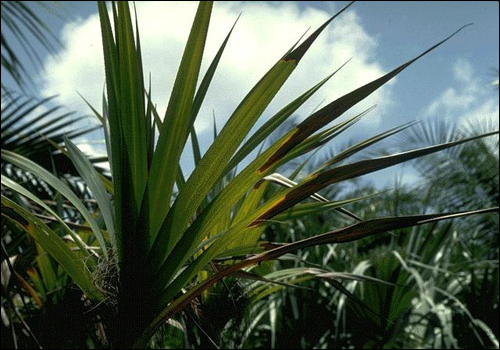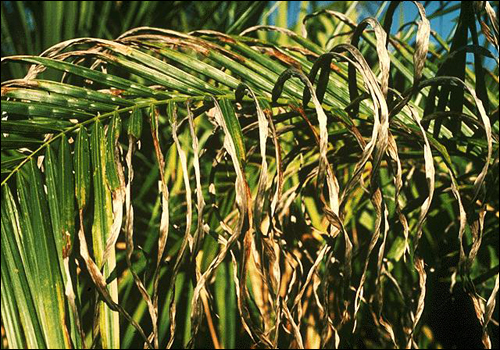Deficiency of Potassium
There is probably a deficiency of Potassium (mobile). Monocots such as palms or pandanus typically exhibit orange yellow, or brown spots on the oldest leaves that may appear translucent if held up to the light. Marginal necrosis of the leaflets or leaves is also typically present. The necrosis often causes the lower leaves to become totally withered or frizzled. As the deficiency progresses, all leaves within the canopy will eventually become symptomatic, followed by stunting and chlorosis of new growth a reduction in stem diameter, and finally death of the plant. Potassium deficiency of Phoenix spp. is similar to that of Magnesium deficiency except the leaflets of Potassium deficient Phoenix spp. have orange-brown rather than bright yellow leaflet tips. Potassium deficiency is very common in South Florida.
Plant is a monocot or noncotyledonous (includes palms, Pandanus, draceanas, yuccas, cycads and others
- Symptoms are most severe on the oldest leaves or throughout the entire plant
- Symptoms are most severe on oldest leaves
- Leaves or leaflets have translucent yellow, orange, or brown spots and/or marginal necrosis
- Symptoms are most severe on oldest leaves
Potassium Deficiency in Fishtail Palm (Caryota mitis)

Potassium Deficiency in Areca Palm (Dypsis lutescens)

Potassium Deficiency in Coconut Palm (Cocos nucifera)

Potassium Deficiency in Princess Palm (Dictyosperma album)

Potassium Deficiency in Spindle Palm (Hyophorbe verschaffeltii)

Potassium Deficiency in Screw Pine (Pandanus utilis)

Potassium Deficiency in Royal Palm (Roystonea regia)

